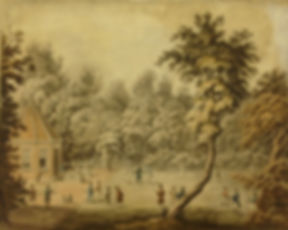
The Pleasure’s of Reffley
Reffley Spring must have already been a popular resort, for the people of Lynn for many years, as described in the following report from 1781:
In a wood near Wootton Gap is a fpring called Riffley Spring, a place of great refort during the fummer feason to the inhabitants of Lynn, who every Sunday meet in parties to drink tea and pafs the afternoon there. There is a pedeftal or obelisk erected in this wood, called Riffley Wood, near the fpring. This wood is about a mile and a half from the toll-gate at Gaywood towards South Wootton…from The History and Antiquities of the county of Norfolk: Freebridge Lynn, Freebridge Marshland, and Gallow January 1st 1781 J Couse Publisher.pages 291-292.
A hundred years ago, when Reffley spring was nearing the end of its popularity, according to a writer of the time:
….there is a spot called Reffley Spring, to which a certain amount
Of interest attaches ; for during the latter part of the eighteenth century and the first quarter of the nineteenth Reffley spring was a famous and popular resort for the townsfolk of Lynn………
…from The Kings Homeland : Sandringham and north west Norfolk 1906.

Reffley Spring aquatint by W H Oldmeadow circa. 1800 by permission of Lynn Museum.
It was in the middle of the 18th century, if legends are to be believed, that what started out initially as a secretive royalist protest group some one hundred years earlier, underwent a remarkable transformation, that has left its indelible, if enigmatic, mark upon the history of Lynn. There were a number of factors, which although individually initially unconnected, that together were responsible for this transformation…..
Although, Reffley Spring was the venue for the Subscribers’ annual meetings, its popularity with the townsfolk of Lynn also increased throughout the 18th and into the 19th centuries. This was at the time that “taking the waters” at Spa towns, was growing in popularity, and especially during the time of the Napoleonic Wars when the continent was closed off to visitors from this country. Reffley Spring, however, came to be known principally as a place of recreation, and the ‘health giving’ and cure side, never took off there.
Reffley spring became popular with the inhabitants of Lynn and surrounding area, not particularly for the healing properties of the waters, so much as, that it was the only woodland area convenient to Lynn, the air there, it was noted, being cleaner than in the town. People moved into towns during the 18th century, which became in parts, overcrowded and smelly, there being no sewage system at that time. Heating and cooking would be by means of wood and charcoal creating smoke in the town, and streets rubbish strewn).(1) From the 1700’s, the people of Lynn used Reffley as a place where they could walk in pleasant surroundings and enjoy fresh air, in the hot summer months, and Reffley Wood was but an hours walk away, for the majority. Only the wealthy would be able to make the journey on horseback or in carriages. So, it became popular in summer to walk the two miles from Lynn of an afternoon, through the Highgate and Gaywood villages, the latter having a population, of 300 at that time, and on towards Castle Rising. Before reaching South Wootton, there was a lane to the right, travelling on past the Carnish Field House and later, the Reffley Spring Farm where hot water for ‘tea’ could be obtained, and then a ‘right of way’ to the Spring itself. The townsfolk would then enjoy a stroll through the woodland. At the height of its popularity, costermongers, purveyors of food and drink and no doubt musicians, would also make their way there. The townsfolk’s day out, would be rounded off with a visit to one of the local hostelries, singing dancing and making merrie, before returning home.
People would come to Reffley from far and wide, in addition to those from the local area. Reffley was even referred to as Lynn’s ‘Vauxhall’ at one time. This being a reference to the famed Vauxhall Gardens in London, which were commercially operated on an altogether much larger scale.
Although, the managed area around Reffley Spring was in no way so large or so ambitious an enterprise as Vauxhall Gardens; it was its association with Lynn’s ‘Subscribers to Reffley Spring’, later to be known as the Reffley Society, the Reffley Bretheren or Sons of Reffley, which has secured it a place in Lynn’s history today, and its former reputation as a ‘popular resort’ now, is all but, forgotten.
Note: Vauxhall Gardens, originally known as New Spring Gardens was believed to have opened before the Restoration of 1660. The Gardens consisted of several acres of trees and shrubs with attractive walks, musical and other entertainments. Initially, entrance was free with food and drink being sold to support the venture. From Wikipedia.

Vauxhall Gardens by Canaletto
Vauxhall had such a winning formula, it was copied across the world. There were Vauxhall’s in Paris, Copenhagen and Nashville in Tennessee.
However, the ‘Vauxhall’ model, despite its fame and popularity, in this country, was in actuality, financially precarious. For instance, it would cost considerable sums to put on ‘events’ there, which could result in financial losses owing to the vagaries of the weather. Eventually the owners of the gardens filed for bankruptcy in the 1840’s. Vauxhall Gardens were put up for auction in September 1841 and it could not be ascertained at the time if the purchaser’s intention was to put the gardens to their original use, or break them up for building ground. The latter opinion was the one that prevailed in the auction room, it was reported. The site was finally auctioned off in 1859.